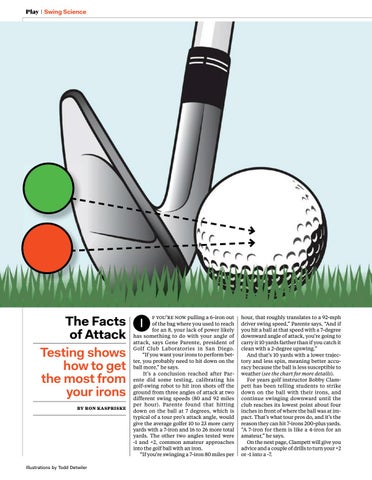Play Swing Science
The Facts of Attack Testing shows how to get the most from your irons BY RON KASPRISKE
Illustrations by Todd Detwiler
F YOU’RE NOW pulling a 6-iron out of the bag where you used to reach for an 8, your lack of power likely has something to do with your angle of attack, says Gene Parente, president of Golf Club Laboratories in San Diego. “If you want your irons to perform better, you probably need to hit down on the ball more,” he says. It’s a conclusion reached after Parente did some testing, calibrating his golf-swing robot to hit iron shots off the ground from three angles of attack at two different swing speeds (80 and 92 miles per hour). Parente found that hitting down on the ball at 7 degrees, which is typical of a tour pro’s attack angle, would give the average golfer 10 to 23 more carry yards with a 7-iron and 16 to 26 more total yards. The other two angles tested were -1 and +2, common amateur approaches into the golf ball with an iron. “If you’re swinging a 7-iron 80 miles per
I
hour, that roughly translates to a 92-mph driver swing speed,” Parente says. “And if you hit a ball at that speed with a 7-degree downward angle of attack, you’re going to carry it 10 yards farther than if you catch it clean with a 2-degree upswing.” And that’s 10 yards with a lower trajectory and less spin, meaning better accuracy because the ball is less susceptible to weather (see the chart for more details). For years golf instructor Bobby Clampett has been telling students to strike down on the ball with their irons, and continue swinging downward until the club reaches its lowest point about four inches in front of where the ball was at impact. That’s what tour pros do, and it’s the reason they can hit 7-irons 200-plus yards. “A 7-iron for them is like a 4-iron for an amateur,” he says. On the next page, Clampett will give you advice and a couple of drills to turn your +2 or -1 into a -7.












